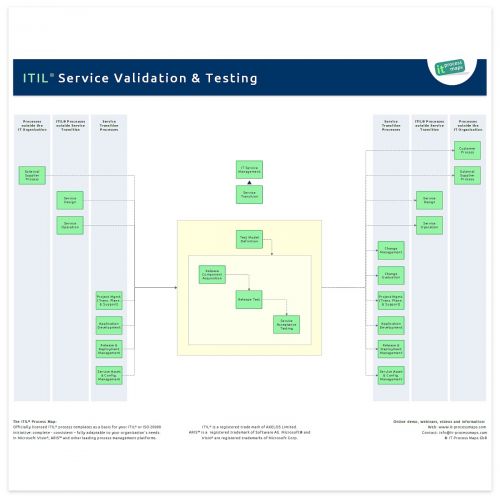Service Validation and Testing

Objective: The objective of Service Validation and Testing is to ensure that deployed Releases and the resulting services meet customer expectations. This ITIL process verifies that IT operations is able to support the new service.
Part of: Service Transition
Process Owner: Test Manager
Process Description

Service Validation and Testing has been introduced as a new process in ITIL V3. Major additions are details on the various testing stages during Service Transition and descriptions of commonly used testing approaches.
In ITIL 2011, additional interfaces between Service Validation and Project Management have been added to make sure that Project Management is constantly provided with current planning information.
The process overview of Service Validation & Testing (.JPG) shows the key information flows (see fig. 1).
ITIL 4 refers to 'Service Validation and Testing' as a service management practice.
Sub-Processes
These are the ITIL Service Validation sub-processes and their process objectives:
Test Model Definition
- Process Objective: To specify in detail how the Release will be tested and quality-assured. In particular, this process defines the testing concept and specific test cases to be used during Service Validation.
Release Component Acquisition
- Process Objective: To acquire the components of a Release and submit them to an initial assessment. This process ensures that only components which meet stringent quality criteria are allowed to enter the intensive testing phase.
Release Test
- Process Objective: To test all Release Components and all tools and mechanisms required for deployment, migration and back out. This process ensures that only components which meet stringent quality criteria are deployed into the live productive environment.
Service Acceptance Testing
- Process Objective: To verify if all conditions are met for the new service to be activated, and to obtain a binding consent from the customer that the new service fulfills the agreed Service Level Requirements.
- Note: If the Release passed all previous quality assurance checkpoints, Service Acceptance Testing should not result in any new errors; if serious defects are discovered, however, it must be decided between customer, Service Level Manager and Release Manager what actions are to follow (→ see Responsibility Matrix).
Definitions
The following ITIL terms and acronyms (information objects) are used in ITIL Service Validation to represent process outputs and inputs:
Development/ Installation QA Documentation
- A documentation of tests and quality assurance measures applied during the development or installation of applications, systems and other infrastructure components (e.g. component tests, code walk-throughs, ...). A complete Development/ Installation Quality Assurance (QA) Documentation testifies that the required QA measures were applied prior to handing a Release component over to Release Management.
Test Model
- A Test Model is created during the Release planning phase to specify in detail the testing approach used for deploying a Release into the productive environment. It is an important input for the Project Plan. Most importantly, this document defines the required quality assurance checkpoints during the Release deployment, as well as the required test scripts.
KPIs
Roles | Responsibilities
Test Manager - Process Owner
- The Test Manager ensures that deployed Releases and the resulting services meet customer expectations, and verifies that IT operations is able to support the new service.
Service User
- A person who uses one or several IT services on a day-to-day basis. Service Users are distinct from Customers, as some Customers do not use IT services directly.
| ITIL Role / Sub-Process | Test Manager | Information Security Manager[3] | Compliance Manager[3] | Service User | IT Operator[3] | Customer[3] | Other roles involved |
|---|---|---|---|---|---|---|---|
| Test Model Definition | A[1]R[2] | - | - | - | - | - | - |
| Release Component Acquisition | AR | - | - | - | - | - | - |
| Release Test | AR | R | R | R | R | - | - |
| Service Acceptance Testing | AR | - | - | R | R | R | R[4] |
Remarks
[1] A: Accountable according to the RACI Model: Those who are ultimately accountable for the correct and thorough completion of the Service Validation and Testing process.
[2] R: Responsible according to the RACI Model: Those who do the work to achieve a task within Service Validation.
[3] see → Role descriptions...
[4] Service Level Manager, Release Manager and Service Owner. → Role descriptions...
Notes
By: Stefan Kempter ![]() , IT Process Maps.
, IT Process Maps.
Process Description › Sub-Processes › Definitions › Roles






